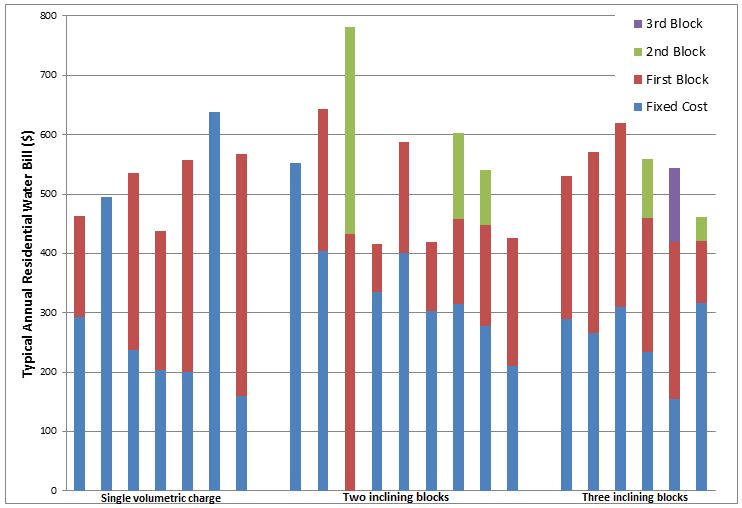Appropriate water pricing is one of the key focus areas for water reforms and national competition policy. Historically cheap water has been treated as a right with some utilities providing water services for less than the cost of provision. Even with metering of consumption, some utilities provide a fixed volume of water (or allowance) in return for the access charge. It is widely recognised that such arrangements, where there is little or no relationship between the water used and the charge, lead to excessive usage by many customers and unfairly high charges for other customers.
Types of Water Pricing Tariffs
There are a number of options for water tariffs that broadly fall into the category of “best practice” water pricing:
Two-Part Tariff
A two-part tariff, now regarded as good practice in water pricing, consists of an access charge and a charge per unit of consumption (volumetric charge). The access charge is usually varied based on the water meter size, to take account of the higher infrastructure cost of higher use customers such as factories.
Inclining Block Tariff
An often used variant of the two part tariff is an “inclining block” or step tariff, where the volumetric charge is divided into a number of bands with increasing usage charges for successive usage bands. The 2011 Productivity Commission Review of the urban water industry argued against Inclining Block Tariffs.
Bundled Water and Wastewater Tariff
It is also becoming more common, particularly for non-residential customers, to base sewerage charges on water usage by applying a discharge factor (ie. a volumetric sewerage charge based on an imputed percentage of water use). The justification behind such a tariff is that water use is reasonably uniform within different customer groups and that the factored water use provides a reasonable estimate of sewage discharge.
Variable or Flexible Tariffs
Seasonal tariffs, where water is charged at a different rate during summer and winter periods have sometimes been considered by the water industry. The philosophy behind seasonal tariffs is that the higher marginal costs of supply in peak periods are reflected in higher prices, making the tariff a useful tool for reducing summer consumption. Variable Tariffs with consumer choice were strongly advocated by the Productivity Commission. The growth in automated metering (which allows greater frequency of consumption data to be captured) has opened more opportunities for time-based charging, however there are no known examples of this being adopted.
An increasing customer focus across the sector will ultimately see increased pressure to better align pricing with customer habits. Many utilities report that the lag between billing and behaviours which might have contributed to a significant billing impact (e.g. 6 monthly meter reads meaning a volumetric charge reflecting high dry season outdoor water use is only conveyed to a customer in the wet season when usage is low) can drive complaints.
In Queensland there is a diversity of water tariffs used by the more than 70 Water Service Providers (WSPs). While some still retain the outdated system of a single fixed charge for water services, most have a two-part tariff. The figure below shows the structure of a typical residential water bill from a selection of WSPs with two-part tariffs.

Figure: Structure of Typical Bill - Annual residential water bill in 2010 for a selection of Queensland Water Service Providers with different types of two-part tariff.
Principles of Water Pricing
Appropriate water pricing is generally underpinned by a number of important principles:
- Alignment with marginal cost. Water charges should be based on the long run marginal cost of the provision of water supply. Long run marginal cost reflects the full cost of supplying water including operating costs, capital expenditure for future augmentation, a return of capital (funding of depreciation), and a return on investment.
- Promotion of conservation. The pricing policy should provide incentives for water conservation.
- Fairness. The pricing policy should be fair (that is charges for users should not result in cross subsidies).
- Revenue sufficiency and stability. Adequate funds must be recouped from customers to maintain and augment the water supply system with the appropriate balance between fixed and water usage charges. The pricing regime should provide a stable source of revenue, not unduly influenced by short and medium term fluctuations in demand.
- Protection for needy customers. Local Governments’ Community Service Obligations (CSO’s) such as discounts for community or sporting organisations should be explicitly reflected in the pricing policy.
- Transparency. Where decisions are made to provide subsidies under CSO’s or incentives schemes, these should be clearly identified and costed.
- Simplicity. The pricing policy should be simple for customers to understand and the Local Government to administer.
- Frequent Billing. Enables the customer to be aware of consumption.
The Queensland Competition Authority outlined the regulatory pricing principles for the water sector in 2000.The Productivity Commission Review of the national urban water industry proposes a modified set of principles, for example removing the externalities of protection of needy customers and the environment to other Policy and regulatory tools.